Business
From Reed to Roof: Thatchers in Picturesque Hampshire

In the charming county of Hampshire, amidst its rolling hills and picturesque landscapes, a unique and ancient craft has thrived for centuries – thatching. Thatching is an art that involves using natural materials like reeds or straw to create roofs for homes and buildings. It’s a tradition that has endured through the ages, preserving the beauty of the countryside and creating stunning, distinctive landscapes. In this article, we will explore the world of thatchers in Hampshire, uncovering their techniques, history, and the enduring appeal of thatched roofs in this idyllic part of England.
The Art of Thatching
Thatching is a skilled trade that demands precision, patience, and a deep understanding of the materials used. In Hampshire, thatchers have perfected their craft over generations, passing down techniques and knowledge from one family member to the next. The most common materials used in thatching are reeds and straw, although other materials like heather and rushes can also be used. These natural materials are not only aesthetically pleasing but also provide excellent insulation and weatherproofing, making them ideal for the British climate.
The Thatching Process
Thatching a roof is a meticulous process that begins with the selection of the right materials. Thatchers in Hampshire often gather reeds from local wetlands, ensuring a sustainable and eco-friendly approach to their craft. The chosen reeds are then carefully bundled and attached to the roof structure using a combination of wooden laths, fixings, and a specialized thatching tool known as a legget.
The thatcher’s skill lies in achieving the perfect pitch and texture for the roof, ensuring it sheds water effectively and endures for many years. The finished result is a roof with a warm, rustic appearance that blends seamlessly with the surrounding countryside.
Thatching Styles in Hampshire
Hampshire is home to a variety of thatching styles, each with its unique charm. Some of the most popular styles include:
- Combed Wheat Reed: This style features tightly combed wheat reed that gives the roof a neat and uniform appearance. It is a popular choice for cottages and traditional English homes.
- Long Straw: Long straw thatched roofs have a more rustic and textured appearance. This style is often used for period properties and farmhouses.
- Water Reed: Water reed thatching is known for its durability and resistance to the elements. It is a common choice for coastal properties along the Hampshire coastline.
Thatching in the Modern Age
While thatched roofs are synonymous with historic charm, they are not confined to the past. Thatching is a thriving industry in Hampshire today, with skilled thatchers continuing to create stunning roofs for both new and existing buildings. Modern techniques and materials have been incorporated to enhance the longevity and sustainability of thatched roofs, ensuring they remain a viable option for homeowners who appreciate their timeless beauty.
Preserving Hampshire’s Thatched Heritage
Hampshire’s thatched roofs are not just a visual delight; they are an integral part of the county’s cultural heritage. The local government and heritage organizations have taken steps to preserve and protect these iconic roofs. Thatchers in Hampshire also play a crucial role in maintaining this heritage by participating in restoration projects and providing expert advice on thatch preservation.
Conclusion
From Reed to Roof: Thatchers in Picturesque Hampshire showcases the enduring artistry of thatchers in this beautiful county. Their dedication to preserving tradition while embracing modern techniques ensures thatched roofs continue to grace Hampshire’s landscape, adding to its timeless charm. As you explore the Hampshire countryside, take a moment to appreciate the thatched roofs that have stood the test of time, connecting the past with the present in a truly picturesque fashion.


